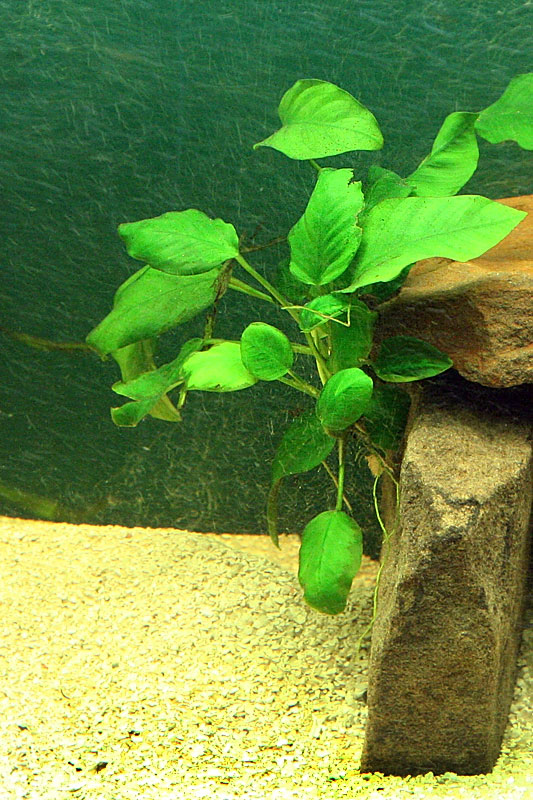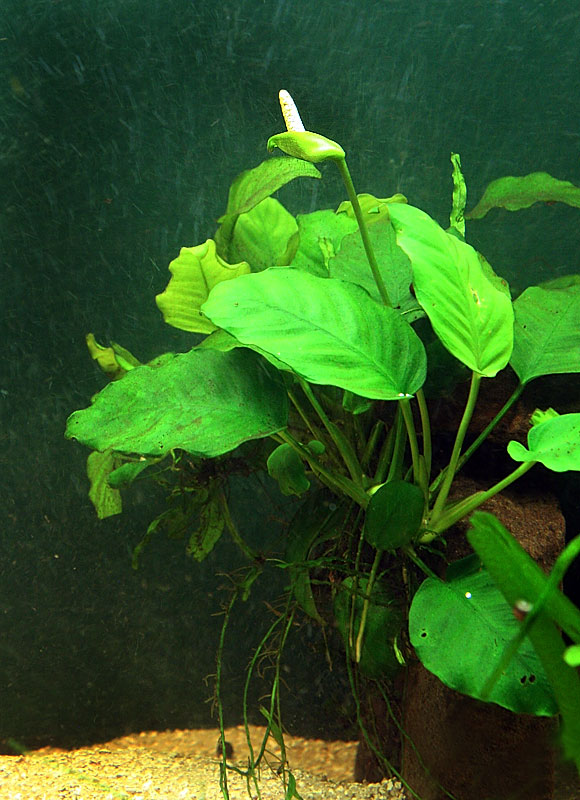Anubias (Anubias sp.)
 I find anubias to be ideal plants for tropheus tanks.
I find anubias to be ideal plants for tropheus tanks.
 Photo taken shortly after planting this anubias. I had never had one hat grew so much!
I bought this anubias plant early in 2008 at an auction of the GAAS. I remember bidding quite a bit of money for it - over $10 - but it was a nice healthy planted that was rooted on a red lava rock. Unfortunately I had to discard the rock, since it did not fit in with my aquascaping in this tank. As you can read in the plant section for my 240G frontosa tank, I didn't have much luck with anubias in the early days of my fish keeping career. In fact, it was only after about 30 years in the hobby that I learned not to plant them in the substrate but wedge them between rocks or attach them to a piece of wood. Since following this strategy, anubias have started to grow very nicely in my tanks, and have become one of my favorite aquarium plants together with Java fern and Java moss.
Anubias seem to be particularly well suited for tropheus tanks, since at least my Tropheus don't eat any part of them, but keep then beautifully cleaned of algae. Algae growth on the leafs can be a problem with anubias in other tanks that don't have the cleaning services of tropheus, since excessive algae growth on the leafs can limit the light uptake of the plant.
Photo taken shortly after planting this anubias. I had never had one hat grew so much!
I bought this anubias plant early in 2008 at an auction of the GAAS. I remember bidding quite a bit of money for it - over $10 - but it was a nice healthy planted that was rooted on a red lava rock. Unfortunately I had to discard the rock, since it did not fit in with my aquascaping in this tank. As you can read in the plant section for my 240G frontosa tank, I didn't have much luck with anubias in the early days of my fish keeping career. In fact, it was only after about 30 years in the hobby that I learned not to plant them in the substrate but wedge them between rocks or attach them to a piece of wood. Since following this strategy, anubias have started to grow very nicely in my tanks, and have become one of my favorite aquarium plants together with Java fern and Java moss.
Anubias seem to be particularly well suited for tropheus tanks, since at least my Tropheus don't eat any part of them, but keep then beautifully cleaned of algae. Algae growth on the leafs can be a problem with anubias in other tanks that don't have the cleaning services of tropheus, since excessive algae growth on the leafs can limit the light uptake of the plant.
 The first flower of the anubias in my 125G tropheus tank, July 2008.
The anubias in my 125G tropheus tank has come up with a total of four flowers over the last few month. These flowers last for a very long time - months - and are fascinating in that they are completely submerged. I am a cichlid man at heart, and although I keep plants in nearly all of my tanks, if in doubt my tanks are set up so that the conditions are ideal for the fish, not for the plants. For this reason, I haven't had too many plants flower in my tanks, but whenever that happened, they used to grow a stem that would lift the flower up above the water level. I was intrigued by the fully submerged flowers of the anubias, and wondered if that was normal, and there was any point in a plant creating a submerged flower, meaning could pollination occur in the water?
The first flower of the anubias in my 125G tropheus tank, July 2008.
The anubias in my 125G tropheus tank has come up with a total of four flowers over the last few month. These flowers last for a very long time - months - and are fascinating in that they are completely submerged. I am a cichlid man at heart, and although I keep plants in nearly all of my tanks, if in doubt my tanks are set up so that the conditions are ideal for the fish, not for the plants. For this reason, I haven't had too many plants flower in my tanks, but whenever that happened, they used to grow a stem that would lift the flower up above the water level. I was intrigued by the fully submerged flowers of the anubias, and wondered if that was normal, and there was any point in a plant creating a submerged flower, meaning could pollination occur in the water?
Hydrophily
Questions posed on Cichlid-forum and the Planted Tank Forum didn't yield much information other than that submerged flowers seem common with Anubias sp. A Google search for 'submerged pollination led to a short Wikipedia entry, explaining that pollination by water is called Hydrophily. Here is a quote from that article:Hydrophily is a fairly uncommon form of pollination whereby pollen is distributed by the flow of waters, particularly in rivers and streams. Hydrophilous species fall into two categories: those that distribute their pollen to the surface of water, and those that distribute it beneath the surface. Surface pollination is rare, and appears to be a transitional phase between wind pollination and true hydrophily, where pollen is completely submerged. Surface hydrophily has been observed in several species of pondweed and waterweed. Species exhibiting true submerged hydrophily include Posidonia australis and ribbonweed.Since submerged flowers in Anubias sp. seem to be quite common, this would appear to suggest that they might be capable of true submerged hydrophily! Here is another quote from a Wikipedia article on pollination. It shows how rare true submerged hydrophily is!
Hydrophily is pollination by water and occurs in aquatic plants which release their seeds directly into the surrounding water. About 80% of all plant pollination is biotic [meaning mediated by an organism]. Of the 20% of abiotically [meaning mediated without the involvement of other organisms] pollinated species, 98% is by wind and 2% by water.In summary, Anubias sp. are fascinating plants that - if planted in the correct way - are perfectly suited for a cichlid tank, and especially for a tropheus tank. Give them a try, and I am sure you won't be disappointed!
Leave a Reply
You must be logged in to post a comment.



